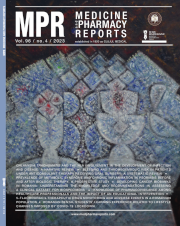Anastomosis between the facial nerve – ansa cervicalis and the facial nerve – hypoglossal nerve in rabbits: technical note for a practical use in peripheral facial palsy
DOI:
https://doi.org/10.15386/mpr-2665Keywords:
anastomosis, neurorrhaphy, facial nerve, hypoglossal nerve, ansa cervicalis, rabbit dissection, facial palsyAbstract
Background and aims. To emphasize the importance of laboratory dissections in perfecting surgical techniques. In this paper, we describe the technical details on rabbit dissection for practical applications.
Methods. Four New Zealand rabbits were distributed into two groups and underwent anastomosis between the Facial Nerve and Ansa Cervicalis (group 1) and between the Facial Nerve and Hypoglossal Nerve (group 2). They were clinically and neurophysiologically evaluated after ten weeks. Electroneurography with skin electrodes were used to identify the motor activity of the involved muscles and nerves. Facial and ipsilateral tongue reinnervation was analyzed 40 weeks after anastomosis. Evoked electromyographic muscle tension was used to evaluate facial and tongue reinnervation.
Results. Facial and ipsilateral tongue reinnervation was analyzed 40 weeks after anastomosis. Recorded evoked potentials showed improvement in facial reinnervation in all four rabbits. Rabbits undergoing FN-HN anastomosis still showed ipsilateral lingual paresis, based on EMG tests. The survival rate was 100%.
Conclusions. The laboratory dissection plays a crucial role in training surgical specialists to achieve favorable patient outcomes. Both types of anastomosis can be used to achieve facial reinnervation; however, it is imperative to prevent ipsilateral lingual paralysis that may arise from using the hypoglossal nerve.
Downloads
Published
How to Cite
Issue
Section
License
The authors are required to transfer the copyright of the published paper to the journal. This is done by agreeing to sign the Copyright Assignment Form. Whenever the case, authors are also required to send permissions to reproduce material (such as illustrations) from the copyright holder.

The papers published in the journal are licensed under a Creative Commons Attribution-NonCommercial-NoDerivatives 4.0 International License.

